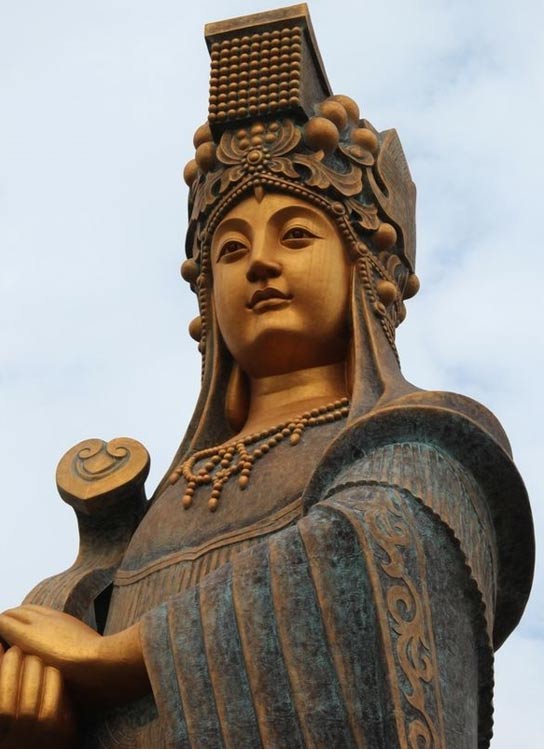
Mazu: Legendary Guardian of the Chinese Seas and Social Media Marvel
Princess of Supernatural Favor, Empress of Heaven, Goddess of the South China Sea - these are just a few of the illustrious titles given to the Chinese goddess Mazu (Mat-su) since her incursion into the Chinese, Taiwanese, and Southeast Asian pantheon in the 11th century AD. The legend of Mazu comes down through the ages in a myriad of ways, alternating in large part based on whether the Buddhists, Taoists, or followers of Confucianism are discussing her. In every telling, however, the core of her person remains the same—filled with kindness and mercy.
Mazu the Human
Mazu is described as a devoted young woman with a strong affection for her family, who is said to have closely worshipped the goddess Guanyin, representing mercy and compassion. As a regular human before she was deified, Mazu was born on March, 23 in 960 AD to Lin Yuan and his wife, and was initially named Lin Moniang. She was born in either the city Meizhou or Fujian, both coastal towns, and quickly became well-known for her strong swimming skill and prowess. The second version of Mazu remains relatively the same, though it is said that she showed supernatural gifts at a young age and was thus raised in the teachings of the Tao from the time she was a child. Her agility in water is the most pertinent aspect of her being and largely the reason why she became the goddess of seafarers, fishermen, and sailors. However, her gifts went beyond excelling in the sport.
- Pangu and the Chinese Creation Story
- The short and brutal rule of Chinese Emperor Fu Sheng, the one-eyed tyrant
- Archaeologists Uncover Tomb of Tyrannical Chinese Emperor

A depiction of Mazu who fell into a trance and saved her father and brothers from drowning who were caught in a terrible storm at sea. (tumblr.com)
Mazu’s Supernatural Gift and Ascension to Deity Status
It is said that one night, her father and four brothers went out to sea and were caught in a terrible maelstrom. Mazu, fearing for her family's lives, fell into a trance and projected her will out to sea in an effort to save them. Astonishingly enough, Mazu was incredibly successful, saving her father and three of her four brothers (or in some variations, her brothers and not her father) from the storm before her mother awoke her and broke the spell. When her family returned to the mainland, the story of her great deed spread and she quickly came to be considered a woman of extraordinary powers.
Not much is recorded of the remainder of her life, but there are two separate accounts of how Mazu died and went on to join the gods in the sky—in both accounts, she remained unmarried and a virgin by choice. Taoists claim that Mazu climbed a mountain when she was 28 and found the Tao while meditating in the open air. Inspired, she leapt off the highest peak and flew to heaven to be sanctioned a goddess. The second telling is that she dove into the sea upon believing that her father was dead and died from the exhaustion of swimming and searching through the tumultuous waves for him. This tale appears to be more regularly circulated, undoubtedly in part because her death in this case is related to her passion and her iconography.
In this version, it is said she died and became a ghost (because of her unmarried status), and began to look out for the sailors and fishermen of China.

Primary Matsu or Mazu statue at Chua Ba Thien Hau (Camau Association of America), Los Angeles, 2006. By Magnus Manske (Wikimedia Commons)
The Goddess Mazu in Art
As a goddess, Mazu is most often depicted in robes of red, as red was often worn while swimming to stand out against the boats and dark waters. Her robes are habitually those of an empress, laced with jewels and holding either a staff or a ceremonial tablet to signify her powers, and atop her head is the flat-topped imperial headdress to ensure she is easily recognized as a woman of great power.
She is not always alone in artistic depictions, but sometimes illustrated beside or between two demons—one called Thousand Miles Eye, shown red with a single horn, and the other known as With the Wind Ear, green with two horns. Both were purportedly demons who loved Mazu and wanted to wed her, and so she claimed that whichever could defeat her would be her husband. Neither did, and instead they became her constant friends and comrades.
- Photographer captures last traces of the ancient tradition of foot binding
- The secret life of an ancient concubine
- The Great Forbidden City of China
Goddess Goes Viral on Social Media
Mazu gained a new set of followers (of the social media kind) after images of a statue of the goddess surfaced in 2017. The pictures showed Mazu and her two demon comrades flying in business class from China's Xiamen to Kuala Lumpur in Malaysia.
The travel took place as part of a cultural exchange tour organized by the Meizhou Mazu Ancestor Temple in China so people in Malaysia and Singapore could also celebrate and honor the sea goddess. The large size of the statues and a gesture of honor meant that business class seating was required. A spokesperson who received the statues in Malaysia explained, “This is basic respect we have for the culture of Goddess Mazu.” And logistically it made sense, “They were also more than 6ft high, so they had to fly business class.”

The tallest statue of Mazu in the world, 2013. Photo by Dli184 (Wikimedia Commons)
Although Goddess Mazu's tale conflicts in some aspects, in many ways, she becomes a much more powerful deity because of it. Her conflictions do not alter the core of the person she was as a human and as a goddess, but they do provide depth to her character, allowing her to fit into numerous roles. As a Buddhist, she represents the compassion of Guanyin by protecting sailors. As a Taoist, she is uniquely versed in their teachings, finding the Tao in the heights of the mountains, proving that such a thing is possible. And to the followers of Confucius, she exemplifies the familial bond by diving headfirst into the sea and searching for the remains of her family for days. She has withstood time as not only an emblem of Asian seafarers but an emblem of each primary Chinese religion.
Featured Image: Beautifully captured photo of Mazu, the goddess of the sea, at Cixian Temple, Taipei. Photograph taken by Joshua Fahler, Taipei. (blog.joshuafahler.net)
By Ryan Stone
References
Birrell, Anne. Chinese Mythology: An Introduction (Johns Hopkins University Press: London, 1993.)
Irwin, Lee, "The Great Goddesses of China", Asian Folklore Studies, Vol. 49, No. 1 (1990), pp. 53–68.
Lee, Lily Xiao Hong and Sue Wiles. Biographical Dictionary of Chinese Women, Volume II (Routledge: United Kingdom, 2015.)
Ruitenbeek, Klaas, "Mazu, the Patroness of Sailors, in Chinese Pictorial Art", Artibus Asiae, Vol. 58, No. 3/4 (1999), pp. 281–329.
Yang, Lihui. Handbook of Chinese Mythology (Oxford University Press: Oxford, 2008.)
"History and Cutstoms." Matsu National Scenic Area. November 11, 2014. Accessed May 14, 2015. http://www.matsu-nsa.gov.tw/user/Article.aspx?a=22&l=2














